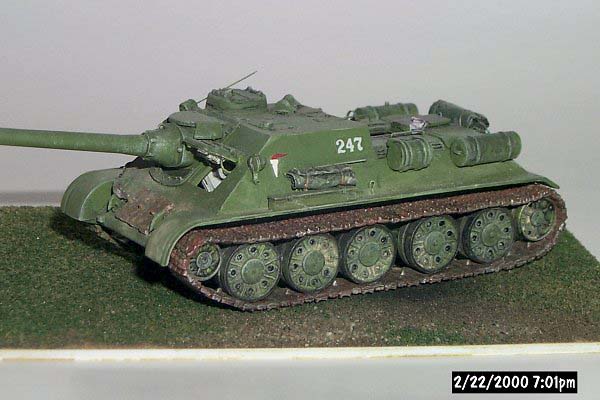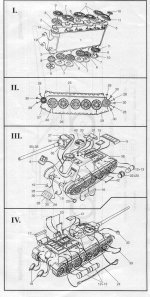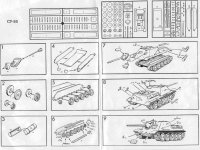
Soviet SU 100 & SU-85 Tank Destroyers of WW2
Article & photos by Stephen Brezinski, Portland, Maine USA

Photo 1: The above photo is of the 1/72 SU-100. Engine compartment is open, a scratchbuilt rudimentary engine installed, and with a wrench and rag next to it. Note the incorrect spacing of the second and third roadwheels. The tow cable was made with twisted fine copper wire and the kit’s cable ends glued on.
Compared to ESCI these kits come from relatively new Belorussian and Russian manufacturers to the US and Western Europe. Besides these two Soviet WW2 assault gun/tank destroyers: a T-34/85 tank and a number of ZIS truck variants are also offered under the Coopertiva, Toga, PST and AER company names. Except for box art, instructions and decals, all these kits under the different company names are the same.
The SU-85 was developed from the T-34/76 as a turretless, well armored self-propelled 85 mm gun, in order to provide a more effective -propelled antitank gun and for infantry support. As the T-34/76 was upgunned to the T-34/85, the SU-85 was in turn up-gunned to the SU-100 with a 100 mm gun, in order to deal more effectively with the German Panther and Tiger tanks. Entering service in 1944, it continued on post-war with the Soviet Union and its European allies, in Korea, and in the Middle East.
Each kit comes in about 118 injection molded styrene parts. I found surface detail to be respectable and the SU-100’s size matches Esci's 1/72 scale T-34 well. [No I did not measure it out to check exact scale.] Getting the SU-100 first I anticipated that the SU-85 would be essentially the same kit though with a few new parts, since they were very similar vehicles. In actuality the two kits are different entirely. While they both have similar construction steps, tracks and surface detail; the SU-100 is more 1/72 scale and the SU-85 kit is slightly smaller in some dimensions. The SU-85 has an older style T-34 roadwheels as well. An odd error with the SU-100 (and its companion T-34/85 kit) is that AER placed the larger roadwheel gap between the vehicle’s third and fourth roadwheels when it actually should be between the second and third roadwheels! I did not catch this until after I built the kit. This error can be fixed during construction by shaving off the third axle from the front, and then repositioning it slightly back. This detail on the SU-85 kit is correct. As this is not a full construction article I refer you to the many excellent references on the web and in our bookstores for better clarification.

Photo #2. Left side of SU-100. Driver’s hatch is open with a rudimentary interior visible. Wire grab handles were added, otherwise no aftermarket parts were used.
I noted quite a problem with fit with my SU-100, particularly with the superstructure and lower hull. It required much filling and sanding to close off the gaps. Like other AER kits, the styrene seemed much softer than what I've encountered with Revell and Hasegawa kits. Extra care then must be taken so as not to sand off too much plastic or break parts. A plus is that the tracks come in molded "link & length" styrene sections like PST and the later Esci kits; except that the Russian kits have well-formed track teeth which are missing from many ESCI styrene tracks. The tracks went together well and are among the best in the scale I've seen. The engine and driver’s hatches I modeled open and a simple engine, driver’s seat and gun breach built. Tow cables were made from twisted copper strands. Etched brass frets for the SU-100 are made by both Eduard (#22019) and by PART (#P72021). I have not noted any frets made for the SU-85 though many brass parts for the SU-100 would be in common with both AFV’s. PART also makes 1/72 etched brass T-34 tracks suitable for these kits.
Toga's kit instructions are adequate and clear, though not as good as AER's. Painting guides are on the box art and instruction sheet. I used a medium Humbrol forest green enamel paint, though I usually prefer Poly-Scale acrylics. No decals were offered in my kit, which is odd, since markings were common on Soviet armor late in the war. I borrowed some decals from AER’s Zis-5 truck kit. Though the kit has some problems, and what kit doesn't, an intermediate level builder should be able to build this into a fine looking vehicle.



I happily recommend this kit. For references, I suggest The Eastern Front book by Zaloga & Grandsen; and Schiffer Publishing’s T-34 book, and the website below:
| Back to Kit Reviews | Back to Home Page |
| Back to AER Kit List |